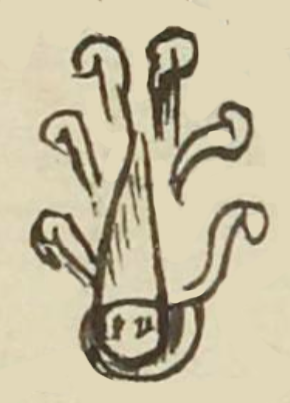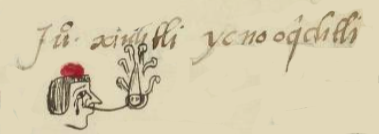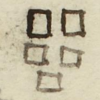Xiuhtli (MH896r)
This black-line drawing of the simplex glyph for the personal name Xiuhtli (“Comet”) is attested here as a man’s name. The glyph shows a descending comet with a triangular tail. The tail has some hatching that seems to give it a three-dimensionality. Six volutes–probably intending smoke–curl off the comet’s tail, three on the left and three on the right. The comet has a circular head with two short, thick parallel marks that seem to give it two eyes.
Stephanie Wood
Some other comet hieroglyphs in this collection appear to have a head with two eyes (see below). Perhaps these are a simplified version of the snake-like comet of the Telleriano-Remensis codex (39v). A couple of comets are shown as turquoise tesserae, but those serve as phonetic indicators, given that xihuitl and xiuhtli are near homophones.
Stephanie Wood
juo. xiuhtli ycnooq~chtli
Juan Xiuhtli, icnooquichtli
Stephanie Wood
1560
Jeff Haskett-Wood
cometas, colas, volutas, cabezas, ojos, serpientes, nombres de hombres

xiuh(tli), comet, https://nahuatl.wired-humanities.org/content/xiuhtli
Cometa
Stephanie Wood
Matrícula de Huexotzinco, folio 896r, World Digital Library, https://www.loc.gov/resource/gdcwdl.wdl_15282/?sp=864&st=image.
This manuscript is hosted by the Library of Congress and the World Digital Library; used here with the Creative Commons, “Attribution-NonCommercial-ShareAlike 3.0 License” (CC-BY-NC-SAq 3.0).









